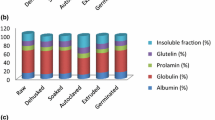Abstract
Two legumes, African yam beans (Sphenostylis stenocarpa) and cowpeas (Vigna unguiculata), were processed into akara, moimoi and porridge then analyzed along with the raw samples for chemical, functional and sensory properties. Results showed that all the samples (raw or processed) had similar and high crude protein content with an average of 20.7%. The cowpea and African yam bean porridges had the highest (22.9%) and the lowest (19.9%) crude protein, respectively, which showed that the two legumes are very good sources of protein. Moimoi made from African yam beans had lower gelation capacity (19.4 w/v), higher water absorption capacity (68.0 ml/g), and lower oil absorption capacity (35.9 ml/g) than that made from cowpeas with 23.6 w/v, 54.0 ml/g and 41.0 ml/g, respectively. Similarly akara made from African yam beans had a higher gelation capacity of 34.5 w/v, water absorption capacity of 71.0 ml/g and a lower oil absorption capacity of 60.0 ml/g compared to that made from cowpeas (30.6 w/v, 57.0 ml/g and 62.02 ml/g respectively). Sensory evaluation showed that moimoi and akara made from African yam beans were not significantly different (p0.05) in color, flavor, texture and overall acceptability compared to those made from cowpeas indicating that African yam beans could be very useful in the preparation of moimoi and akara. In general, processing into akara and moimoi improved the oil absorption capacity of the African yam beans. The improved capacity to bind fat would be useful in ground meat formulations such as sausage in addition to the usefulness in making moimoi and akara.
Similar content being viewed by others
References
AOAC (1990) Official Methods of Analysis, 15th edition, Washington DC: Association of Official Analytical Chemists.
Okaka JC, Potter NN (1979) Physico-chemical and functional properties of cowpea powder processed to reduce beany flavour. J Food Sci 44: 1235–1240.
Beuchat LR (1977) Functional and electrophorestic characteristics of succinated peanut flour protein. J Agric Food Chem 25: 258–262.
Coffman CW, Garcia VO (1977) Functional properties and amino acid content of a protein isolate from mung bean flour. J Food Technol 12: 473–484.
Nwokolo E (1996) African yam bean (Sphenostylis Stenocarpa Hoechst ex. A. Rich Harms). In: Nwokolo E, Smart J (eds), Food and Feed from Legumes and Oils. Chapman and Hall Pub pp 183–188.
Oshodi AA, Fagbemi JN (1991) Chemical composition and functional properties of full fat flutted pumpkin seed flour (Telfaria occidentalis). Nig Food J 9: 29–30.
Giami SY (1993) Effects of processing on the proximate composition and functional properties of Cowpea (Vigna unguiculate) flour. Food Chem 47: 153–158.
Abbey BW, Ayuh EJ (1991) Functional properties of the African yam bean flour (Sphenostylis Stenocarpa Hoechst ex A Rich Harms). Nig J Nutr Sci 12: 9–14.
Lin MJY, Humbert ES, Sosulski FN (1974) In: Alschull AM (ed), Processed Plant Protein Food Stuff. New York: Academic Press Publ, pp 79–90.
Singh U, Singh B (1991) Functional properties of sorghum peanut composite flour. Cereal Chem 68: 460–463.
Author information
Authors and Affiliations
Rights and permissions
About this article
Cite this article
Achinewhu, S., Akah, G. Chemical, functional and sensory properties of processed African yam beans (Sphenostylis stenocarpa) and cowpeas (Vigna unguiculata). Plant Foods Hum Nutr 58, 1–6 (2003). https://doi.org/10.1023/B:QUAL.0000040364.74521.d8
Issue Date:
DOI: https://doi.org/10.1023/B:QUAL.0000040364.74521.d8




